Key takeaways:
- Timing in music is essential for emotional expression and creating a cohesive sound within ensembles.
- Using a metronome, subdividing beats, and practicing with recordings are effective techniques to improve timing skills.
- Consistency in practice and self-evaluation, such as recording sessions, fosters significant progress in timing and musical expression.
- Collaboration with other musicians enhances understanding of timing and creates a joyful, shared musical experience.
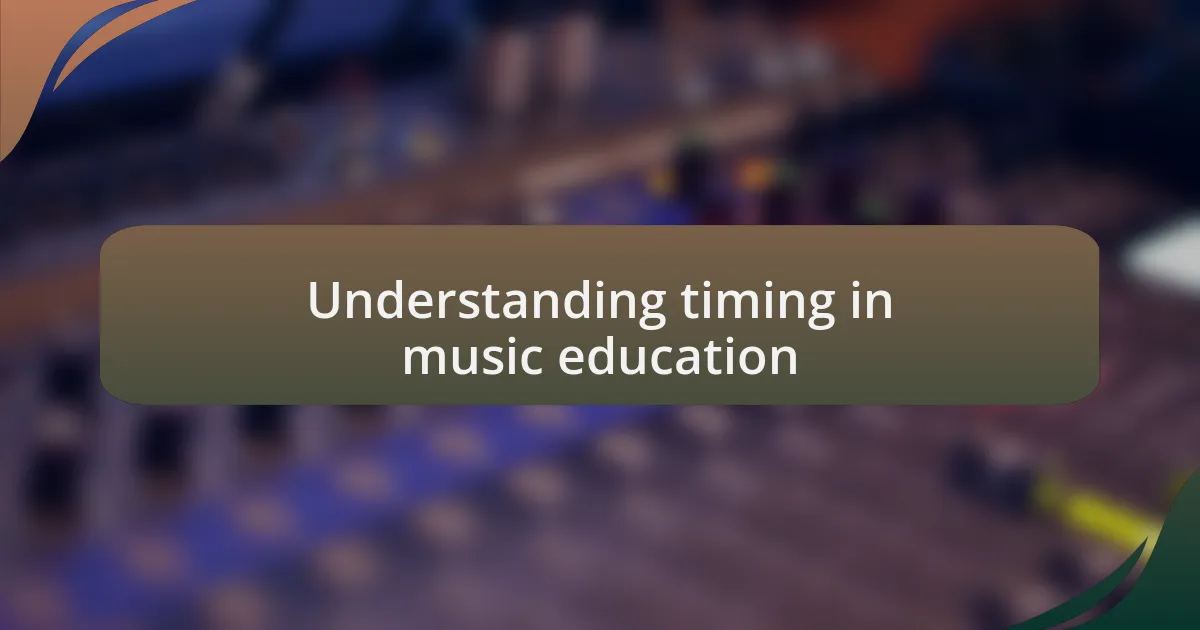
Understanding timing in music education
Timing in music education is often seen as a technical skill, but it’s so much more than just counting beats. I remember sitting in my first rhythm class, feeling overwhelmed by the complexities of tempo and meter. Have you ever experienced that moment when everything clicks, and you just feel the pulse driving your music? It’s a transformative feeling that deepens your connection to the rhythm.
As I improved my timing skills, I discovered that timing isn’t solely about following a metronome; it’s about listening and interacting with other musicians. One memorable performance taught me how to sense the flow between players, as we instinctively adjusted our tempo to create a cohesive sound. This leads me to ask: how often do we pause to consider the communal aspect of timing in music? It has a profound effect on the overall musical experience.
Moreover, understanding timing enriches the emotional expression in music. I recall a practice session where I deliberately played slightly behind the beat; the result was a feeling of longing and tension that captivated my audience. Timing can evoke powerful emotions, transforming a simple melody into a poignant story. Have you ever found that adjusting your timing changes the way a piece feels to you or your audience? It’s a reminder that timing is not just a technical measure but an essential part of musical storytelling.
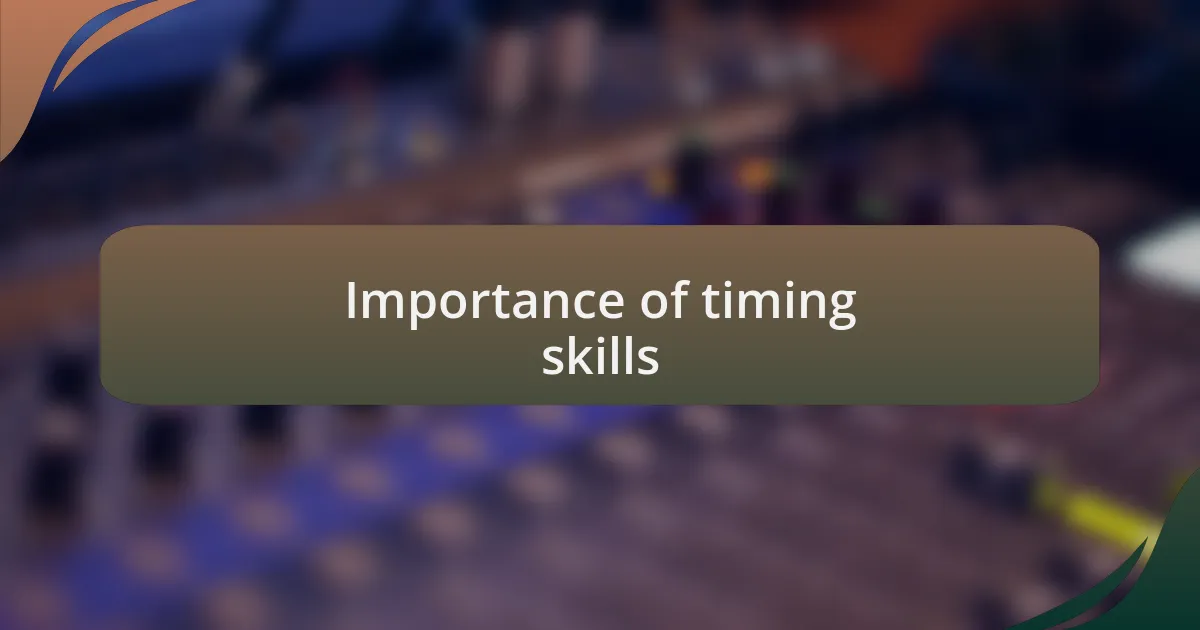
Importance of timing skills
Timing skills are foundational in music, impacting both individual performance and ensemble play. I remember the first time I played with a group; we struggled to synchronize our phrases, creating a disjointed sound. That experience made me realize how crucial timing is—not just for keeping a steady beat, but for conveying the music’s emotional depth. How does it feel when everyone locks into the groove? It creates a shared moment that transcends mere notes and rhythms.
The beauty of timing also shines in its ability to shape musical dialogue. One day, during a jam session, I noticed how each musician responded to the others, almost like a conversation. If one person delayed a note or pushed ahead, the entire group adjusted, creating a dynamic interplay that was exhilarating. Have you ever experienced that in a live setting? The unpredictability of timing adds excitement, making every performance unique.
Moreover, mastering timing allows for artistic expression which can transform a performance. I distinctly recall an instance when I intentionally rushed a section in a piece to evoke urgency and excitement. The shift in timing brought a new life to the music, demonstrating that timing isn’t just functional—it’s a tool for expression. I often wonder: how much can timing influence your artistic voice in music? It’s fascinating to explore the myriad ways timing can embody emotional nuances that resonate with both the musician and the audience.
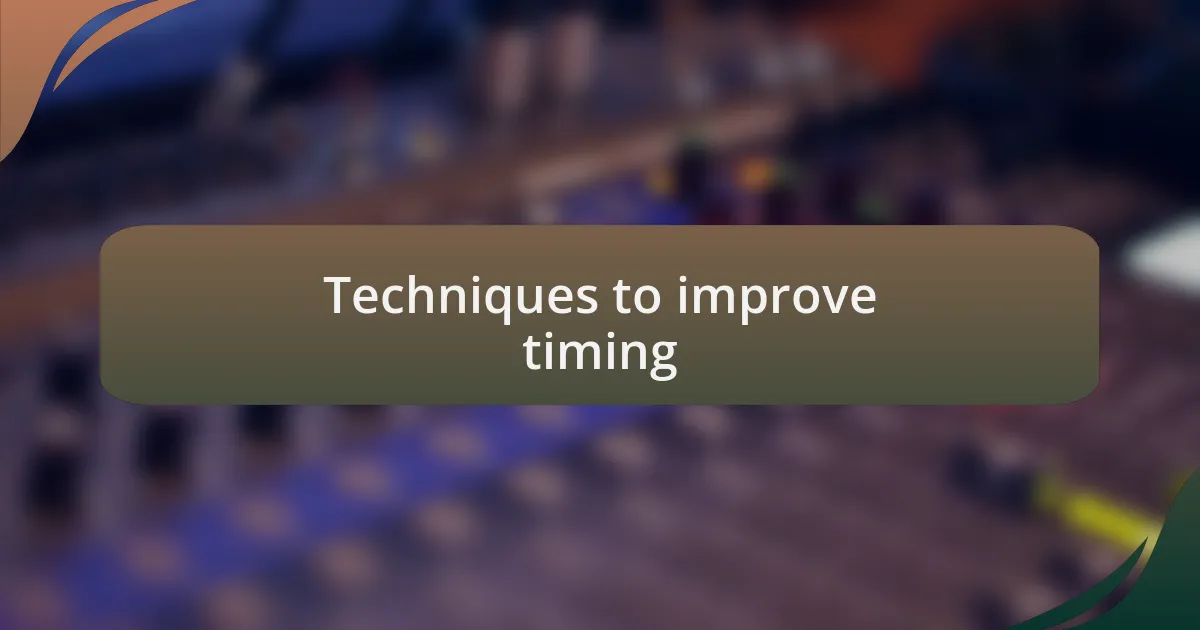
Techniques to improve timing
Certainly! Here are some paragraphs focused on techniques to improve timing:
One of the most effective techniques I discovered was using a metronome. Early in my practice, I often ignored it, thinking I could feel the beat without help. However, when I committed to playing along with a metronome, my sense of time sharpened dramatically. I’ve found it’s crucial to start slow; this way, you can really internalize the rhythm before increasing the speed. Have you tried it? The precision can be surprisingly liberating.
Another technique I embraced is the practice of subdividing beats. I remember a time in my jazz ensemble when the drummer suggested this approach. Initially, I struggled to keep track of the subdivisions, but as I practiced, it opened up a whole new level of groove. This technique teaches your brain to recognize smaller rhythmic units, making it easier to maintain a steady pulse when playing complex pieces. Could there be a more satisfying moment than syncing flawlessly with your ensemble? I think not.
Lastly, playing along with recordings has been a game-changer for my timing. I vividly recall jamming to my favorite tracks, trying to mirror the subtle variations in timing the artists used. This not only challenged my timing but also expanded my musical vocabulary. Have you ever noticed how a slight delay or rush can transform a phrase? That’s the beauty of timing; it can make the familiar feel fresh and exhilarating, which is why I believe integrating this into my practice routine has been invaluable.

Practicing with a metronome
Using a metronome can truly revolutionize your practice sessions. At first, I viewed it as just another tool, something that felt mechanical and rigid. But when I began to embrace the steady tick, I realized it helped me maintain consistency even in the most complex rhythms. Have you ever noticed how a small change in tempo can impact your playing? It’s enlightening to see how even a single beat per minute can transform your performance.
What really struck me was the balance between discipline and creativity when practicing with a metronome. One day, while playing scales, I made a conscious effort to play each note precisely with the click. It felt almost like a dance, where every note had its own space and time. This rhythmic connection deepened my understanding of music and the importance of each beat. Do you remember that moment when you finally clicked with a piece? That feeling is something every musician strives for.
As I continued to work with a metronome, I started experimenting with varying its tempo in my exercises. I would challenge myself to play faster while maintaining accuracy, which often led to moments of frustration. Nevertheless, pushing through those tough spots taught me resilience. I began to associate the metronome not just with timing, but also with perseverance in my musical journey. How often do we let a tool like this shape our practice more profoundly than we expect?

Using rhythm exercises effectively
As I explored the world of rhythm exercises, I found that dedicating a portion of my practice time specifically to these exercises made a significant difference. I began with simple clapping patterns, which felt oddly freeing and exhilarating. Do you remember the satisfaction of nailing a tricky rhythm after repeated attempts? It’s like unlocking a new level in your music journey.
Another effective strategy was incorporating rhythm exercises into my warm-up routines. Instead of diving straight into scales, I would spend a few minutes with different rhythmic patterns, using my hands to tap out complex subdivisions. This not only warmed up my fingers but also set a vibrant tone for the entire practice session. Have you ever noticed how starting with rhythm can shift your mindset? It creates a playful atmosphere that encourages creativity.
Over time, I discovered that practicing rhythms with other musicians brought a new layer of joy and challenge. Playing along with friends pushed me to listen more carefully, honing my ability to stay in sync. That moment of collective groove when everyone locks in is truly magical, isn’t it? It taught me that rhythm is not just about timing; it’s also about connection.
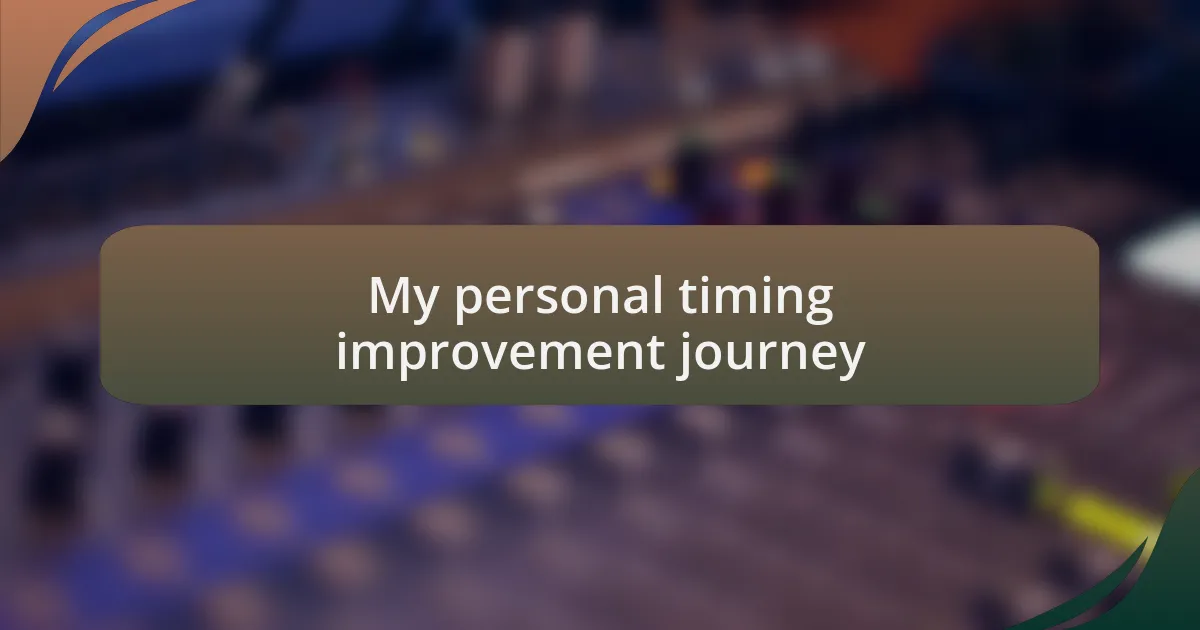
My personal timing improvement journey
My journey in improving my timing skills was far from straightforward. I vividly remember the frustration of stumbling through pieces, feeling like I was always a beat behind. One day, during rehearsal, a fellow musician pointed out that my inconsistency could be traced back to the way I internalized rhythms. It was a game-changer. I started to mentally count beats during practice, and suddenly, I felt more in control. Have you ever experienced that “aha” moment where everything just clicks?
As I delved deeper into my timing improvement, I began incorporating a metronome into my daily practice. At first, it felt mechanical and rigid, but over time, it transformed my playing. I challenged myself with various tempos, even pushing my boundaries. This not only sharpened my precision but also made me realize the importance of flexible timing. Isn’t it fascinating how something as simple as a ticking sound can revolutionize your musical expression?
Sharing this journey with my peers has been invaluable. I recall one memorable jam session where we pushed each other to explore syncopation and off-beat accents. The laughter and camaraderie during those moments reinforced my belief that timing is a collective experience. It’s incredible how the energy of playing together can elevate your understanding of rhythm. Have you considered how collaboration can enhance your musical timing? For me, it certainly has!
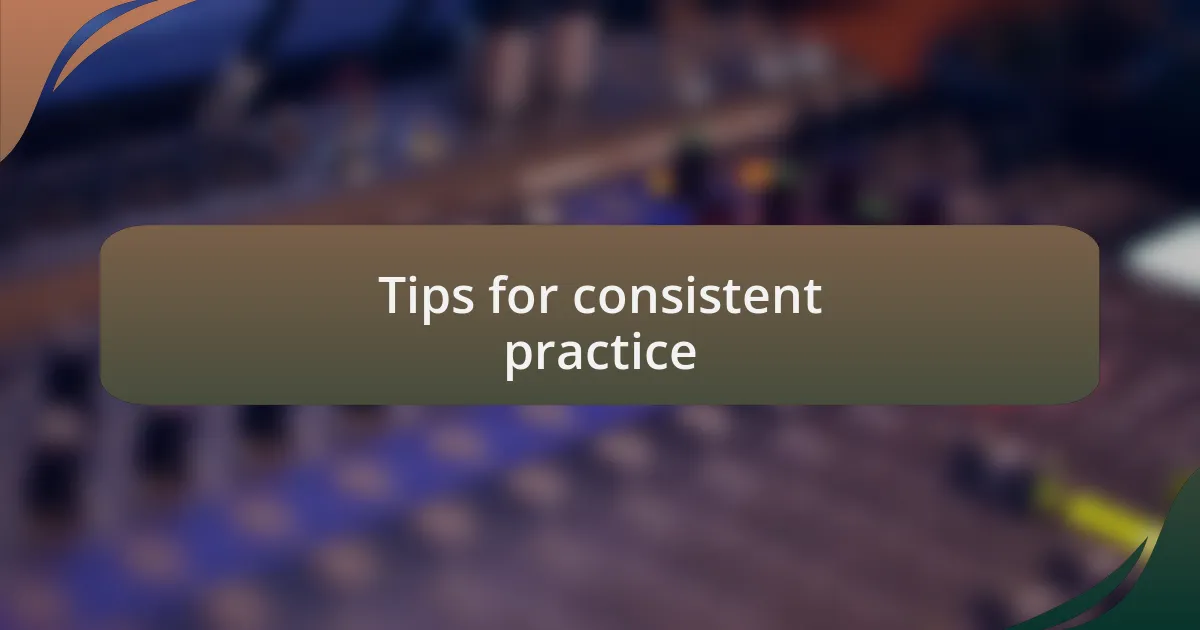
Tips for consistent practice
Consistent practice is about developing habits that stick. I found that setting aside just 15 minutes each day to focus solely on timing worked wonders. This daily commitment created a space for gradual improvement, and I felt myself becoming more comfortable as the days turned into weeks. Have you ever noticed how small, consistent efforts lead to significant progress?
Another tip that helped me immensely was breaking practice sessions into focused segments. For instance, I would dedicate one day exclusively to playing with a metronome, while another day highlighted clapping or tapping out rhythms away from my instrument. This variety kept my practice fresh and engaging. It made me realize that intentionality in my practice keeps me motivated. Have you ever tried mixing up your practice routine to keep it from feeling monotonous?
Lastly, I discovered the power of self-evaluation by recording my practice sessions. Hearing my timing under the microscope exposed areas for improvement I hadn’t noticed in real-time. I started to appreciate the journey of refining my skills and embraced the imperfections along the way. Have you ever listened to your recordings and felt a sense of both pride and determination to get better? It’s a humbling experience that drives growth.